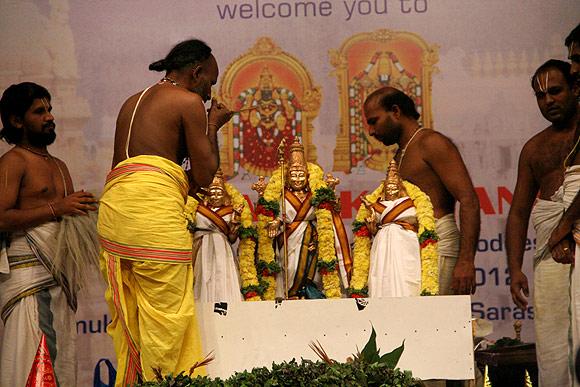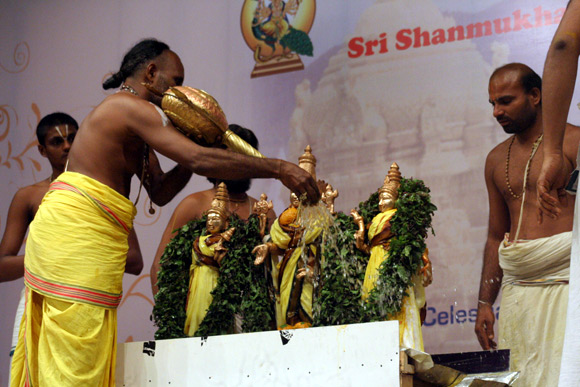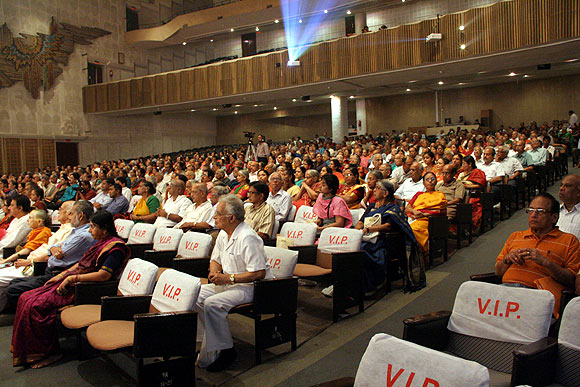Photographs: Sanjay Sawant/Rediff.com
It was a special hallowed moment that eager devotees had been patiently waiting a very, very long time for.
They turned up in enormous numbers to witness this remarkable spectacle.
Their revered deity, the magnificent and all-powerful Lord of Tirumala Tirupati Balaji and his consorts Goddesses Sridevi and Bhudevi were in Mumbai, all the way from the temple town of Tirupati, in Andhra Pradesh, for a three-day divine marriage ceremony in the bustling metropolis.
For the first time, the gods residing at the Temple of the Seven Hills, Venkateswara (who is also called Balaji and is a supreme avatar of Vishnu) and his consorts were brought to a locality in Navi Mumbai for the ceremony.
Incidentally Venkateswara is the name for the god who destroys the sins of the people. Vishnu out of special respect for his followers was incarnated as Venkateswara to come and offer salvation in the Kali Yug era. He is considered one of the highest forms of Vishnu.
Prior to this divine wedding, the priests from Tirupati conducted a ceremony called Vasantotsavam October 16 in Mumbai. During the rite, scents were applied to Lord Balaji and his consorts, while priests recited Vedic chants.
The ritual Abhishekam or religious bathing occurred thereafter. The god and his consorts were grandly bathed in holy water, milk, curd (yogurt), honey, turmeric and sandal paste. Special pujas were performed for the trio and they were decked up amidst chanting of Srinivasa Govinda, Venkatesa Govinda.
...
When Lord Balaji came to Mumbai to wed
Photographs: Sanjay Sawant/Rediff.com
The Vedic volume, Pancharatna Aagamam prescribes an elaborate procedure for this unique and colourful heavenly marriage.
In fact the manner in which the marriage was conducted had been ordained by Lord Balaji and is quite similar to how a Hindu marriage, between mere mortals, would occur, beginning with a homa or havan, ie a special worship.
The ceremony culminated in the Thirumangalya Dharanam or the tying of the mangalsutra (the sacred thread of love and goodwill) amidst the chanting of Mangalyam Tantunanena or hymns blessing the couple and the deafening roll of drums.
There is a celestial purpose to conducting the Lord's marriage. It is said to be done for the protection and prosperity of the world. Everyone -- from the Lord and his consorts, the priests and the devotees, with single-minded focus -- channel their thoughts towards creating global harmony.
...
When Lord Balaji came to Mumbai to wed
Photographs: Sanjay Sawant/Rediff.com
The gods too must circle the sacred fire seven times -- or Sapthapathi -- to be well and truly married.
A coconut is then passed between the bride(s) and groom or Thengai Uruttal (the priests, of course, facilitate this) and the Shanthi Homam and Poornahuthi (concluding puja) follows.
Aasheervadam (blessings) is the final act of this divine wedding drama and then an aarti is performed.
The ceremony was repeated on October 18.
The marriage ceremony on October 17 and 18 was for the benefit of members of the Shanmukhananda Fine Arts and Sangeetha Sabha but a special darshan (showing) was organised for the public.




article